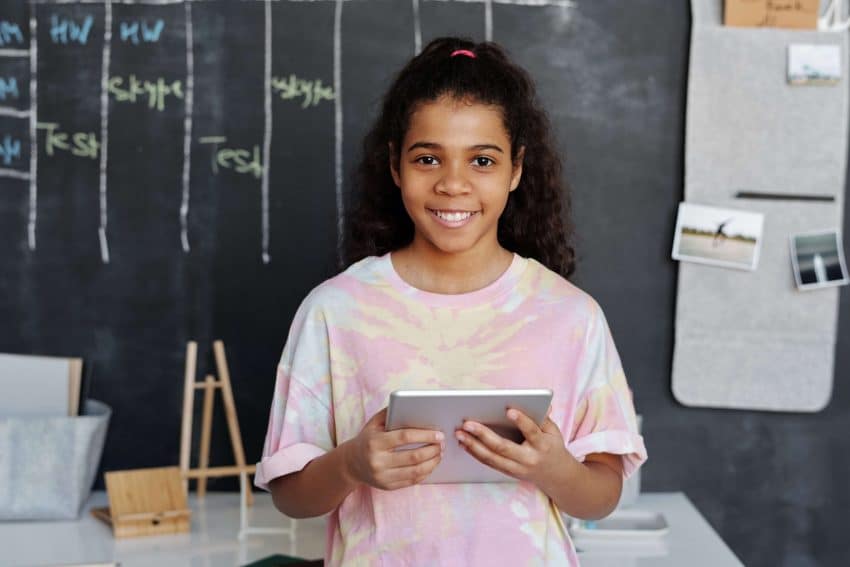AI In Education: Where Is It Now And What Is The Future
Updated: February 13, 2024
Published: March 10, 2021

AI is a technology that is rapidly spreading throughout many industries, and education is no exception. AI is quickly becoming a popular tool in classrooms and schools around the world. In fact, according to a study conducted by IDC, 92% of institutions are already using AI technology regularly.
AI in education takes on many forms and can be used by anyone involved in an academic setting, such as teachers, students, and administrative members. Artificial intelligence in education can be used in the classroom for any age group, making this an exciting and evolving technology.
Keep reading to learn more about how AI is already used in education today and how we expect it to be used in schools in the future.
Photo by Julia M Cameron from Pexels
What is AI?
First things first, it’s important to establish an understanding of what AI is. AI stands for artificial intelligence. Before you get too worried, the AI we know today is not the stuff of sci-fi, and it doesn’t refer to futuristic robots who are coming for our jobs.
AI may also be called machine intelligence and refers to the simulated human intelligence in computer systems and programs or in machines. In case you’re thinking that this is a completely foreign concept, you’d be surprised to learn that you likely use AI in your daily life already. For example, Apple’s Siri and Google’s Alexa both use voice recognition powered by artificial intelligence.
How Is AI Used In Education Today?
AI is already being used in educational institutions and classrooms around the world. Without a doubt, the way students learn and the way teachers instruct has changed with the introduction of machine learning. Here are 4 ways that AI is being used in education today.
1. Make Administrative Tasks Simpler
AI can help teachers with their administrative tasks, leaving them more time to focus on preparing lessons and teaching. Tasks like grading exams can be sped up by using AI technology and software that helps teachers streamline this normally long process.
It’s not only teachers that benefit from artificial intelligence in education. Other administrative staff can turn to AI to help with admissions and classifying large amounts of paperwork, as well.
2. Personalized Learning Experience
We’re used to having everything from ads to suggested content presented to us based on our personal preferences. When it comes to education, AI is doing the same thing. Not every student in a classroom learns at the same level as their peers, so by using AI to do things like personalized assignments or even exam questions, each student gets the same course material catered to their abilities.
For example, software such as Carnegie Learning is being used by students from elementary school to college. This program uses AI to provide feedback on assignments as well as personalized testing and learning.
3. Teachers and AI Work Together
It’s difficult for a single teacher to provide the same level of care and attention to every student in their classroom. However, together with AI, teachers can now address the needs of individual students a lot more efficiently.
The examples we’ve already seen, such as simplifying admin tasks and using specialized software to offer a personalized learning experience, free up a lot of time for teachers. But of course, despite all their technological advancements, machines can’t do it all. The extra time teachers have due to AI learning can then be better used to provide more individualized attention to a greater number of students.
4. More Universal Learning
Students learn at different levels, but they also have different needs and backgrounds. In a single classroom, you might have students who speak different native languages or have impairments or disabilities that make the way they learn unique.
AI helps bridge the gap between these students by offering programs and software, such as Presentation Translator, that can translate a presentation or course material. This makes learning more accessible to a wider number of students, including those with hearing or visual disabilities.
Advantages of AI for Students
Photo by August de Richelieu from Pexels
AI is helpful for everyone involved in education. Still, the focus of any educational institution is its students. There’s no denying that AI is a powerful tool that has the ability to make everyone’s lives easier, but it’s particularly suited for students.
With AI programs and apps, students can choose to learn anywhere and at any time by logging in at their convenience. Furthermore, with apps that provide immediate feedback or function like a virtual teacher, students don’t need to wait long periods of time between learning sessions.
These virtual teachers can’t replace a real human teaching, but it can help students track their progress more instantly, encouraging them to be more active in their own education.
Additionally, due to the nature of AI and its ability to adapt and personalize content according to each user, students are able to practice more self-directed learning and work on subjects or topics that they struggle with. For example, if a student uses an AI-powered app to prepare for an exam and they often make the same mistake on a single topic, the app will consistently provide more exercises until the student gets a better understanding of their mistake and how to correct it.
Advantages of AI for Educators and Schools
Teachers see the same advantages as students, but they see it from a different perspective. For example, just as students use AI learning apps to work on their weaknesses and topics they struggle with, teachers can use this information to understand how to better focus their lessons.
It’s no secret that younger generations like to spend a lot of time on devices like phones or tablets. Learning through AI-powered apps is a more fun way to study both inside and outside the classroom, making it easier for teachers to engage their students.
The more schools, educators, and students continue to use AI, the smarter it will become. As schools and educators see what students are interested in learning based on interactions with apps and programs, they will have an easier time developing curriculums and course materials.
What Does the Future of AI in Education Look Like?
Education artificial intelligence isn’t going anywhere. Its presence in the classroom and in schools is only going to increase, so it’s ideal to get on board sooner rather than later.
While we can’t know exactly how artificial intelligence in education will grow, we can make certain predictions based on how it’s already used. The way AI is used now will be finetuned and made more accurate as the technology becomes more developed.
For example, the way students learn with AI apps will become more sophisticated and detailed to be able to analyze data more effectively, creating an even more personalized experience for students.
Aside from AI apps, virtual reality games and software are likely to become more predominant in classrooms. Virtual reality AI can allow students to get first-hand experience, which makes learning easier and more interactive. Science experiments can be performed with such technologies, making a safer and more engaging environment for students.
For schools themselves, AI will be used to create smart classrooms and smart buildings. We already have the technology where things like temperature, alarms, and lights are controlled remotely by AI-powered apps. Using this technology in schools can turn buildings into both more secure environments for students and more efficient to manage for administration.
To Wrap Up
The use of AI in education is nothing to be afraid of. In fact, it’s a positive thing. AI is a highly advanced tool that can be used to make learning easier and more accessible for students and teachers at all levels. With these new technologies, students have the power to take their education into their own hands with more personalized learning at any time they like.
At University of the People, we’re big believers in individualized learning that can be done at a student’s convenience. That’s why our learning method is entirely based on distance learning where students can get personal attention in small classrooms and earn a degree while studying at their own pace.


